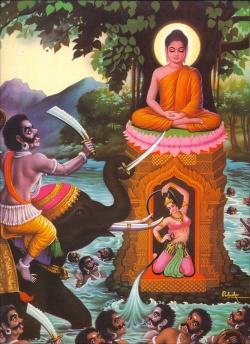Four maras
Revision as of 19:20, 7 March 2014 by Adminos (talk | contribs) (Created page with "thumb|250px| The '''four maras''' (Skt. ''catvāri māra''; Tib. བདུད་བཞི་, ''dü shyi''; Wyl. ''bdud bzhi'') a...")
The four maras (Skt. catvāri māra; Tib. བདུད་བཞི་, dü shyi; Wyl. bdud bzhi) are the four types of obstructive, 'demonic' forces (sometimes also translated as 'demons') which create obstacles to practitioners on the spiritual path. It is important to understand that they have no inherent existence and are only created by the mind.
There are two categorizations of the four maras:
- one according to the Sutrayana, and
- one according to the Vajrayana, which is especially related to the teachings on the practice of chö.
According to Sutrayana
- the mara of the aggregates (Skt. skhandamāra; Tib. ཕུང་པོའི་བདུད་, Wyl. phung po'i bdud), which symbolizes our clinging to forms, perceptions, and mental states as ‘real’;
- the mara of the destructive emotions (Skt. kleśamāra; Tib. ཉོན་མོངས་ཀྱི་བདུད་, Wyl. nyon mongs kyi bdud), which symbolizes our addiction to habitual patterns of negative emotion;
- the mara of the Lord of Death (Skt. mṛtyumāra; Tib. འཆི་བདག་གི་བདུད་, Wyl. 'chi bdag gi bdud), which symbolizes both death itself, which cuts short our precious human birth, and also our fear of change, impermanence, and death; and
- the mara of the sons of the gods (Skt. devaputramāra; Tib. ལྷའི་བུའི་བདུད་, Wyl. lha'i bu'i bdud), which symbolizes our craving for pleasure, convenience, and ‘peace’.
According to Vajrayana
- the tangible mara (Tib. ཐོགས་བཅས་ཀྱི་བདུད་, Wyl. thogs bcas kyi bdud)
- the intangible mara (Tib. ཐོགས་མེད་ཀྱི་བདུད་, Wyl. thogs med kyi bdud)
- the mara of exultation (Tib. དགའ་བྲོད་ཀྱི་བདུད་, Wyl. dga' brod kyi bdud)
- the mara of conceit (Tib. སྙེམས་བྱེད་ཀྱི་བདུད་, Wyl. snyems byed kyi bdud)
Further Reading
- Khenpo Ngawang Palzang, A Guide to the Words of My Perfect Teacher, pages 245-247.
- Jamgön Mipham Rinpoche, Gateway to Knowledge, VOL II (Hong Kong, Boudhanath & Esby: Rangjung Yeshe Publications, 2000), page 161.
